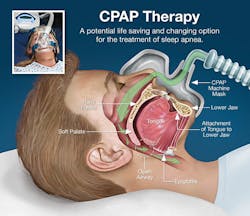Long haul trucker Bob Stanton has been using a CPAP machine for 14 years. He is on the road three to four weeks at a time, and, in addition to driving, Stanton works for Dedicated Sleep, an Oregon company for whom he does CPAP compliance coaching. He does not believe that CPAP is appropriate for all sleep apnea sufferers. Other remedies (or no intervention at all for mild cases) may be more suitable and medically indicated. Indeed, he says that some drivers who have been prescribed CPAPs have been incorrectly diagnosed or given the wrong therapy.
However, for those drivers for whom CPAP is the best fix for their sleep apnea, but are not compliant, he offers these tips:
"The first problem is usually their mask. There are multiple styles and your mask has to be properly fitted. A common problem is truckers pull the straps too tight. Most of the masks are designed to float on your face. People have leaks around their mask and they try to solve the leaks by pulling the straps as tight as possible. This actually worsens the problem."
Stanton notes that sometimes poorly trained or rushed technicians don't give users the proper instructions or let the users leave the office before their instructions are clearly understood. The new user must take the initiative to make certain that he knows how to use the device, he says.
"The second most common problem is humidification," says Stanton. "Good CPAP machines provide heated humidification to the pressurized air. If the driver doesn’t know to fill the water chamber with water and it's never explained to him how to adjust it for a comfortable humidity level then they get drying of the airways. They'll get bloody noses. It's horrible." He adds that users can benefit by doing nasal irrigation with a sterile saline solution. Pre-packaged sprays are practical for truckers because they don't need a sink to irrigate their nasal passages. "It sounds gross but it feels great," says Stanton.
Next is working with your treatment provider on the pressure settings. "If the pressure is too high for what you need, you will get what we call the 'burps and farts.' The medical term is aerophagia. It's where you're getting air forced past the epiglottis and that air has got to go somewhere. It either comes up or it goes down." He notes that CPAPs have a feature called 'ramp' that helps to adjust the pressure. "It's a personal comfort preference whether you like a good amount of pressure when you put the mask on and are trying to fall asleep, or whether you want the pressure to start out low and slowly build up to your normal treatment pressure after you fall asleep. Some people like ramp; some people don't. It's also a matter of knowing whether or not your machine even has ramp and whether you want to turn it on or off."
Another feature that some machines have is Exhalation Pressure Release or EPR. Upon breathing out the machine will automatically back the pressure off. "It makes it easier to breathe against the machine," Stanton says. He adds that users should experiment to learn if they like the feature and which setting – low, medium or high – suits them best.
Another complaint Stanton hears is 'mask marks,' which are red marks on users' faces from the straps. "There are pads that you can buy to go over the straps. When I do a truck show, I’ve got a mask set up with a full set of pads. When you put that mask on it almost feels like you have a pillow on your face. It’s all soft and fuzzy."
The last issue Stanton encounters is claustrophobia. "Some users feel closed in by their masks. Some drivers may need a full face mask because they sleep with their mouths open. They're mouth breathers. They need a full face mask. Others don't. But again, a lazy sleep tech setting up a patient on CPAP will just throw them on a full face mask because then they don’t have to figure out whether they're a mouth breather or not."
Stanton takes some carriers to task for insisting that drivers use their CPAPs but contract with a provider that doesn't include adequate coaching. "When a fleet has a contract with a sleep apnea testing treatment provider that was bid on a lowest cost basis, one of the places and problems is that the coaching often gets left out." However, the situation is improving. "Carriers are getting smarter and including in their contracts that the treatment provider has to provide the compliance coaching."
About the Author

Larry Kahaner
Larry Kahaner is an author, journalist, and former FleetOwner contributor.
